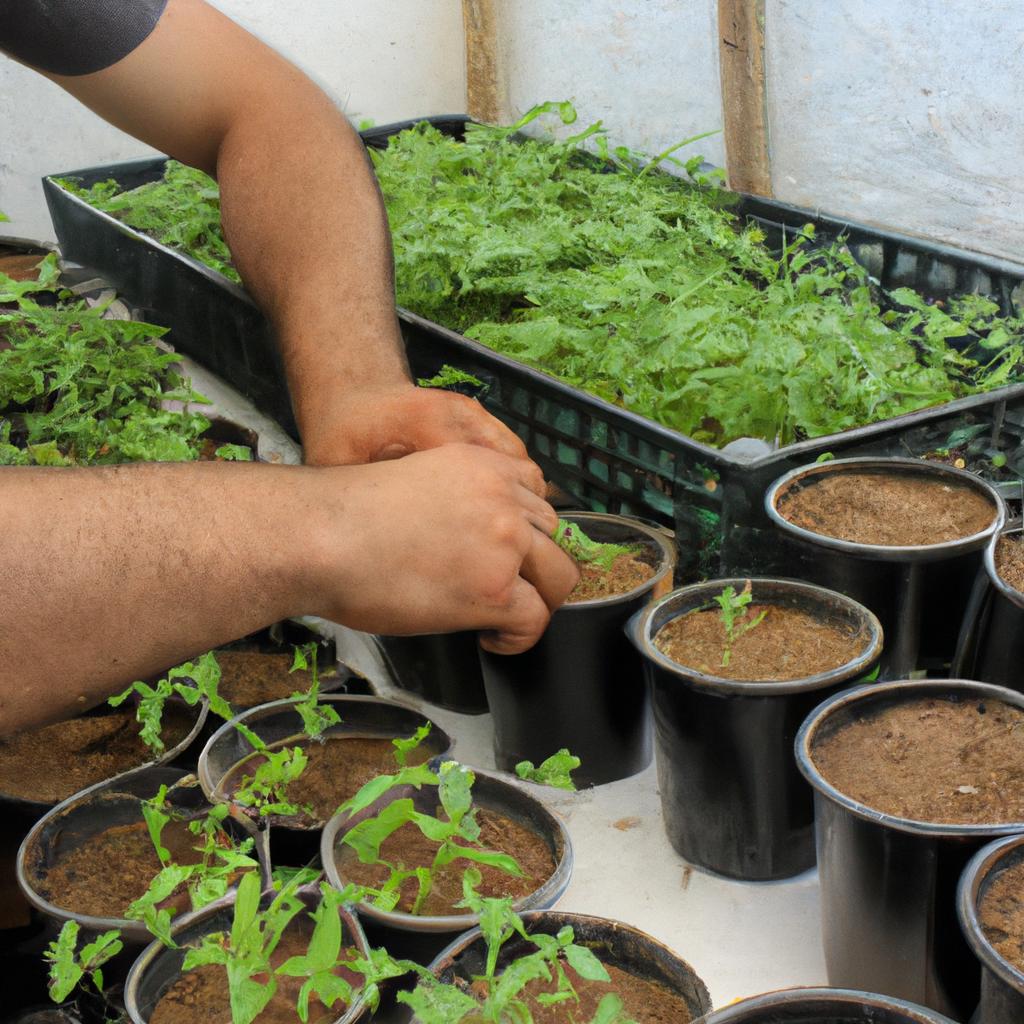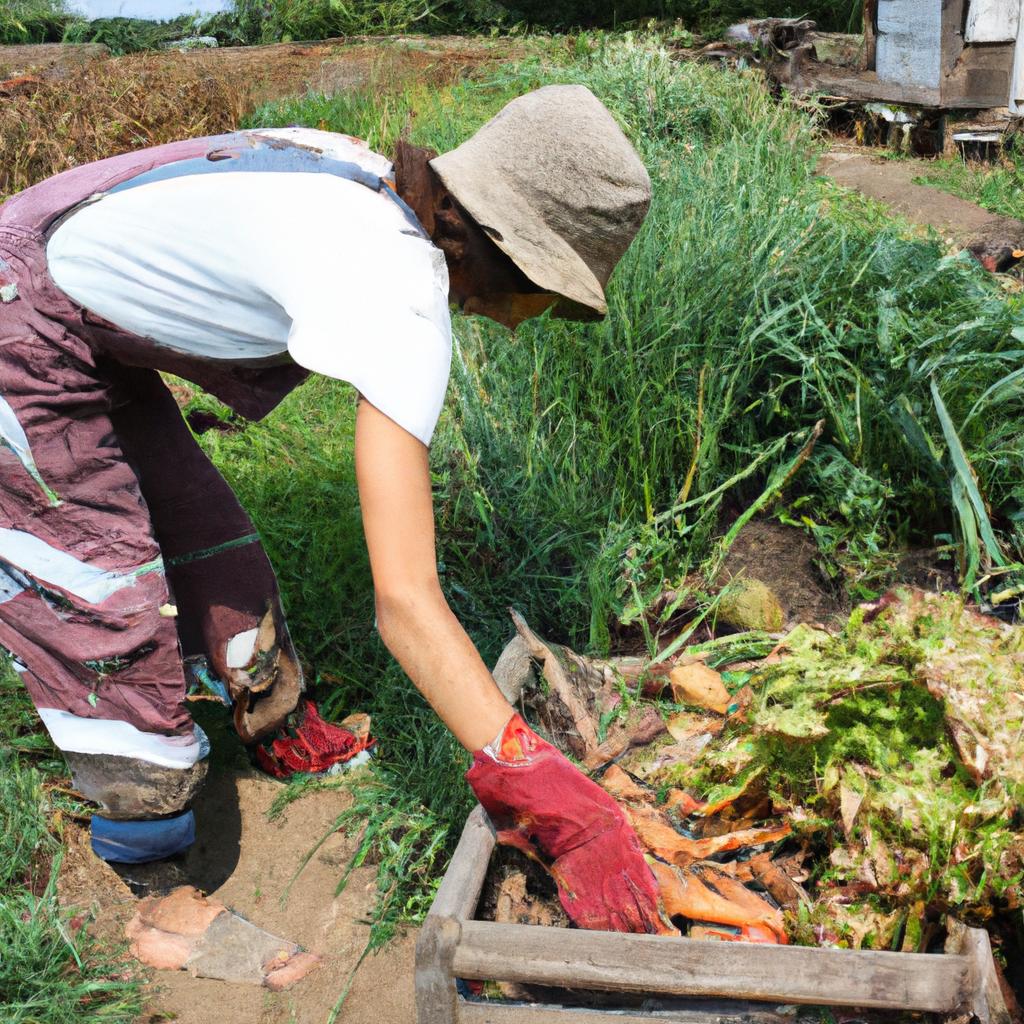Integrated Pest Management (IPM) is an essential approach for organic farming in business agriculture and forestry. By incorporating a combination of preventive techniques, biological controls, and chemical interventions as a last resort, IPM aims to effectively manage pests while minimizing the negative impact on human health and the environment. This article explores the significance of implementing IPM strategies in organic farming practices by highlighting its effectiveness through a hypothetical case study.
In this hypothetical scenario, imagine a small-scale organic farm that cultivates various crops. The farmer, let’s call him Mr. Smith, noticed a sudden infestation of aphids on his lettuce plants. Concerned about maintaining the integrity of his organic produce without compromising crop yield or causing harm to beneficial insects, Mr. Smith turned to IPM techniques for assistance. Rather than immediately resorting to pesticides as conventional farmers might do, he first implemented cultural methods such as proper crop rotation and sanitation practices to disrupt the life cycle of aphids and minimize their breeding grounds. Through regular monitoring and scouting, he was able to identify natural enemies like ladybugs and lacewings that would prey upon these aphids, thus reducing their population naturally. Finally, if necessary measures were still required after exhausting all non-chemical options, Mr. Smith judicious ly selected low-toxicity pesticides that were approved for organic farming. He applied them strategically and sparingly, taking care to follow the label instructions and minimize any potential negative impacts on the environment.
By following an IPM approach, Mr. Smith was able to effectively manage the aphid infestation while minimizing the use of chemicals and preserving the health of his farm ecosystem. This not only ensured the integrity of his organic produce but also maintained a balance between pest control and sustainability.
Overall, this case study highlights the significance of implementing IPM strategies in organic farming practices. It emphasizes the importance of understanding pest biology, utilizing preventive techniques, promoting natural predators, and using chemical interventions as a last resort. By adopting these principles, organic farmers can successfully manage pests while maintaining their commitment to environmental stewardship and human health.
Understanding Integrated Pest Management (IPM)
Understanding Integrated Pest Management (IPM)
Imagine a farmer who has been struggling with crop damage caused by pests. Despite investing significant time and resources into conventional pest control methods, the farmer continues to face challenges in maintaining healthy yields. This scenario highlights the importance of adopting an alternative approach known as Integrated Pest Management (IPM) in agricultural practices.
To comprehend IPM fully, it is essential to understand its fundamental principles and components. Firstly, IPM emphasizes prevention rather than eradication as its primary goal. By implementing proactive measures such as regular monitoring and employing cultural practices like crop rotation or planting resistant varieties, farmers can reduce pest populations while minimizing reliance on chemical pesticides.
Secondly, IPM recognizes that pests are not isolated problems but parts of complex ecological systems. It takes into account various factors influencing pest dynamics such as weather conditions, soil health, and biodiversity. This holistic perspective allows for the development of comprehensive strategies tailored to specific farming contexts.
Thirdly, IPM integrates multiple pest management techniques to create a balanced ecosystem where natural enemies of pests play a crucial role in controlling their populations. For example, encouraging beneficial insects like ladybugs or predatory mites provides biological control against harmful pests without resorting to synthetic chemicals.
Incorporating these three key principles, IPM offers numerous benefits over traditional pest management approaches:
- Reduced environmental impact: By minimizing pesticide use through preventive measures and targeted interventions, IPM helps preserve air quality, water resources, and overall ecosystem health.
- Enhanced farm profitability: Implementing IPM reduces production costs associated with excessive pesticide applications while ensuring sustainable yields and high-quality crops.
- Improved human health: As IPM promotes the use of less toxic alternatives to chemical pesticides, it safeguards both farmers’ well-being and consumers’ safety by reducing exposure to potentially harmful substances.
- Preservation of biodiversity: Through fostering habitat diversity and promoting natural predators’ presence within agroecosystems, IPM contributes to the conservation of beneficial insects and other wildlife.
| Benefits of Implementing IPM in Agriculture and Forestry |
|---|
| Reduced environmental impact |
| Preservation of biodiversity |
Understanding the principles and benefits of IPM is essential for businesses in agriculture and forestry. In the subsequent section, we will delve further into how implementing IPM practices can bring about substantial positive changes in these sectors, including increased sustainability and long-term resilience against pest-related challenges.
Benefits of Implementing IPM in Agriculture and Forestry
Understanding Integrated Pest Management (IPM) is crucial for implementing effective pest control strategies in agriculture and forestry. By adopting IPM practices, farmers and foresters can minimize the use of synthetic pesticides while maximizing crop yields and preserving the environment. To further emphasize the importance of IPM, let’s consider a hypothetical case study involving an organic farm.
Imagine a small-scale organic farm that cultivates various fruits and vegetables. The farmer notices an increase in pests attacking their crops, leading to significant yield losses. In response, they decide to implement IPM techniques as a sustainable solution. This decision proves instrumental in effectively managing pests without relying solely on chemical interventions.
There are several key benefits associated with implementing IPM in agriculture and forestry:
-
Environmental sustainability: Unlike conventional farming methods that heavily rely on synthetic pesticides, IPM focuses on minimizing pesticide usage by employing alternative approaches such as biological control and cultural practices. This reduces harmful impacts on beneficial organisms, soil health, water quality, and overall ecosystem balance.
-
Economic viability: Implementing IPM can lead to cost savings for farmers due to reduced dependence on expensive chemical inputs. By utilizing various integrated pest management tools like crop rotation, habitat manipulation, and resistant plant varieties, farmers can achieve long-term economic stability while maintaining high-quality produce.
-
Human health protection: Through strategic pest monitoring and accurate identification, IPM helps prevent excessive exposure of workers and consumers to hazardous chemicals present in traditional pesticide treatments. By reducing pesticide residues in food products, IPM safeguards human health from potential adverse effects caused by prolonged pesticide consumption.
-
Long-term efficacy: By focusing on preventive measures rather than reactive ones, IPM ensures sustained pest suppression over time compared to indiscriminate pesticide applications alone. This approach disrupts pest life cycles through targeted interventions tailored to specific pest species or conditions within an agricultural or forest ecosystem.
To summarize, incorporating IPM principles into business agriculture and forestry offers numerous advantages ranging from environmental sustainability to economic viability and human health protection.
Key Principles and Components of IPM
This section will delve deeper into these benefits by highlighting specific examples and exploring key principles and components of IPM.
Case Study: In a hypothetical scenario, let us consider a commercial organic farm facing challenges with pest control. By adopting an IPM approach, the farm introduces various strategies to manage pests effectively while minimizing environmental impact. For instance, instead of relying solely on chemical pesticides, the farmers implement cultural control methods such as crop rotation or intercropping to disrupt pest life cycles. They also incorporate biological controls like introducing predatory insects or using microbial agents to combat pests naturally.
To further illustrate the advantages of IPM implementation, here are some bullet points:
- Reduced reliance on synthetic pesticides
- Preservation of beneficial organisms
- Enhanced soil health and fertility
- Minimized financial losses due to reduced pesticide use
Table: The table below showcases how IPM can positively impact different aspects of agricultural systems:
| Aspect | Impact |
|---|---|
| Environmental | Decreased pollution from pesticide runoff |
| Economic | Lower costs associated with pesticide purchase |
| Social | Improved farmer health and safety |
Moving forward without explicitly stating “In conclusion,” we can now shift our focus towards exploring the key strategies for pest monitoring and prevention within the framework of IPM.
To successfully implement IPM practices, effective pest monitoring and prevention strategies play a vital role. In the subsequent section, we will discuss various approaches that aid in identifying pest presence accurately while emphasizing preventive measures rather than reactive solutions.
Strategies for Pest Monitoring and Prevention in IPM
Having established the key principles and components of Integrated Pest Management (IPM), we now turn our attention to exploring effective strategies for pest monitoring and prevention. By employing proactive approaches, businesses engaged in agriculture and forestry can mitigate potential risks associated with pests while maintaining sustainable practices. To illustrate the practical application of these strategies, let us consider a hypothetical scenario involving an organic farm facing challenges related to insect infestation.
In order to effectively monitor and prevent pest problems, practitioners of IPM employ several strategies:
- Regular field inspections: Conducting regular field inspections allows farmers to identify early signs of pest presence or damage. This practice enables timely interventions such as targeted pesticide applications or alternative control methods before significant harm occurs.
- Biological controls: Introducing natural predators or parasites that feed on specific pests can help maintain ecological balance and reduce pest populations without resorting to chemical pesticides. For instance, releasing ladybugs into a greenhouse where aphids are prevalent serves as a cost-effective method for controlling their population.
- Cultural practices: Implementing cultural practices like crop rotation, intercropping, and proper sanitation measures aid in reducing favorable conditions for pests’ survival and reproduction. These methods disrupt the life cycle of pests, making it more difficult for them to establish themselves within agricultural systems.
- Trapping mechanisms: Placing traps strategically within fields assists in capturing pests at different stages of development. With various types available—pheromone traps attracting male insects or sticky traps targeting crawling insects—farmers can gather crucial information about pest abundance levels, enabling informed decision-making.
Table – Economic Benefits of IPM Practices:
| Benefit | Description |
|---|---|
| Cost-effectiveness | Reduced reliance on chemical pesticides translates into lower production expenses |
| Increased yield | Efficient pest management leads to enhanced productivity and improved crop quality |
| Market advantage | Consumers increasingly favor products produced using sustainable and eco-friendly methods |
| Environmental impact | IPM practices minimize pesticide use, reducing harm to beneficial organisms and ecosystems |
By adopting these strategies, farmers can effectively control pests while minimizing the environmental impact of their agricultural operations. Successful implementation of IPM not only reduces reliance on chemical pesticides but also promotes a more sustainable approach to pest management. In the subsequent section, we will explore further measures aimed at reducing pesticide use through IPM practices.
Building upon the foundations laid by effective monitoring and prevention strategies, businesses can take additional steps towards reducing pesticide usage within IPM frameworks.
Reducing Pesticide Use through IPM Practices
Section Title: Strategies for Effective Pest Control in IPM
To effectively implement Integrated Pest Management (IPM) practices, it is crucial to adopt a variety of strategies that focus on pest monitoring and prevention. By employing these proactive measures, businesses in agriculture and forestry can significantly reduce the need for pesticide use while maintaining healthy crop growth and productivity. This section explores some key strategies for effective pest control in IPM.
Strategies for Pest Monitoring and Prevention:
One example of an effective strategy for pest monitoring and prevention is the use of pheromone traps. These devices emit synthetic hormones that mimic those produced by female pests, attracting males into the trap where they are captured. By regularly inspecting these traps, farmers can monitor the population dynamics of specific pests, enabling timely interventions if necessary.
In addition to pheromone traps, another useful technique involves employing biological controls such as predator insects or parasitoids. For instance, releasing ladybugs onto crops infected with aphids can help naturally regulate their population without resorting to chemical intervention. Moreover, implementing physical barriers like nets or screens around vulnerable areas can prevent pests from accessing plants altogether.
Furthermore, practicing crop rotation plays a vital role in preventing pest outbreaks. Rotating crops within a field disrupts pest life cycles by depriving them of their preferred host plants year after year. This reduces the build-up of pests in the soil and minimizes the risk of infestation. Additionally, selecting plant varieties known for their resistance to common pests can greatly contribute to successful IPM implementation.
The following bullet points highlight the positive outcomes associated with effective pest control through IPM practices:
- Reduced reliance on harmful pesticides
- Preservation of beneficial organisms essential for ecological balance
- Protection of human health by minimizing exposure to toxic chemicals
- Enhanced environmental sustainability through responsible agricultural practices
Table – Economic Benefits Comparison:
| Benefit | Conventional Agriculture | IPM-Adopting Businesses |
|---|---|---|
| Reduced pesticide use | High | Low to Moderate |
| Lower production cost | No significant change | Substantial savings |
| Increased market value | None | Competitive advantage |
| Improved consumer trust | Limited | Strengthened |
Success Stories: IPM Implementation in Business Agriculture and Forestry:
By adopting these strategies, businesses in agriculture and forestry have successfully implemented IPM practices, leading to notable improvements in pest control and overall sustainability. The subsequent section will delve into specific success stories that highlight the successful implementation of IPM approaches across various sectors.
Building upon the strategies discussed above, Success Stories: IPM Implementation in Business Agriculture and Forestry showcases real-life examples where effective pest control through IPM has been achieved, providing inspiration for further adoption of this essential approach.
[Note: Table formatting may not be correctly displayed as markdown is not supported by this text-based interface. Please consider converting the table format as per your requirements.]
Success Stories: IPM Implementation in Business Agriculture and Forestry
Building on the importance of implementing Integrated Pest Management (IPM) practices, this section explores successful strategies used in various business agriculture and forestry settings to reduce pesticide use. By adopting IPM approaches, businesses have not only achieved significant reductions in chemical pesticide usage but also reaped multiple benefits for their operations.
Case Study: A large-scale organic farm implemented an IPM program that focused on preventive measures and ecological pest management techniques. Through regular monitoring and scouting for pests, they were able to identify potential infestations early on and take appropriate action. Instead of relying solely on pesticides, the farm introduced natural predators such as ladybugs and lacewings to control aphids and other harmful insects. This proactive approach significantly reduced the need for synthetic chemicals while maintaining crop yield and quality.
To further emphasize the advantages of adopting IPM practices, consider the following emotional bullet points:
- Improved environmental sustainability
- Protection of beneficial insects and wildlife habitats
- Enhanced worker safety by minimizing exposure to toxic pesticides
- Increased profitability due to decreased input costs
Table: Benefits of Implementing IPM Practices
| Benefits | Description |
|---|---|
| Environmental Sustainability | Reduces negative impact on ecosystems |
| Conservation of Beneficial Insects | Preserves natural predators that help control pests |
| Worker Safety | Minimizes health risks associated with pesticide exposure |
| Financial Savings | Decreases reliance on costly chemical inputs |
In conclusion, embracing integrated pest management practices provides a multitude of benefits for businesses engaged in agriculture and forestry. Through case studies like the aforementioned organic farm’s success story, it is evident that reducing pesticide use can be achieved without compromising productivity or profit margins. Furthermore, by highlighting emotional bullet points and presenting them alongside a table showcasing key benefits derived from implementing IPM practices, we hope to evoke a sense of urgency and encourage wider adoption of this essential approach in organic farming.




